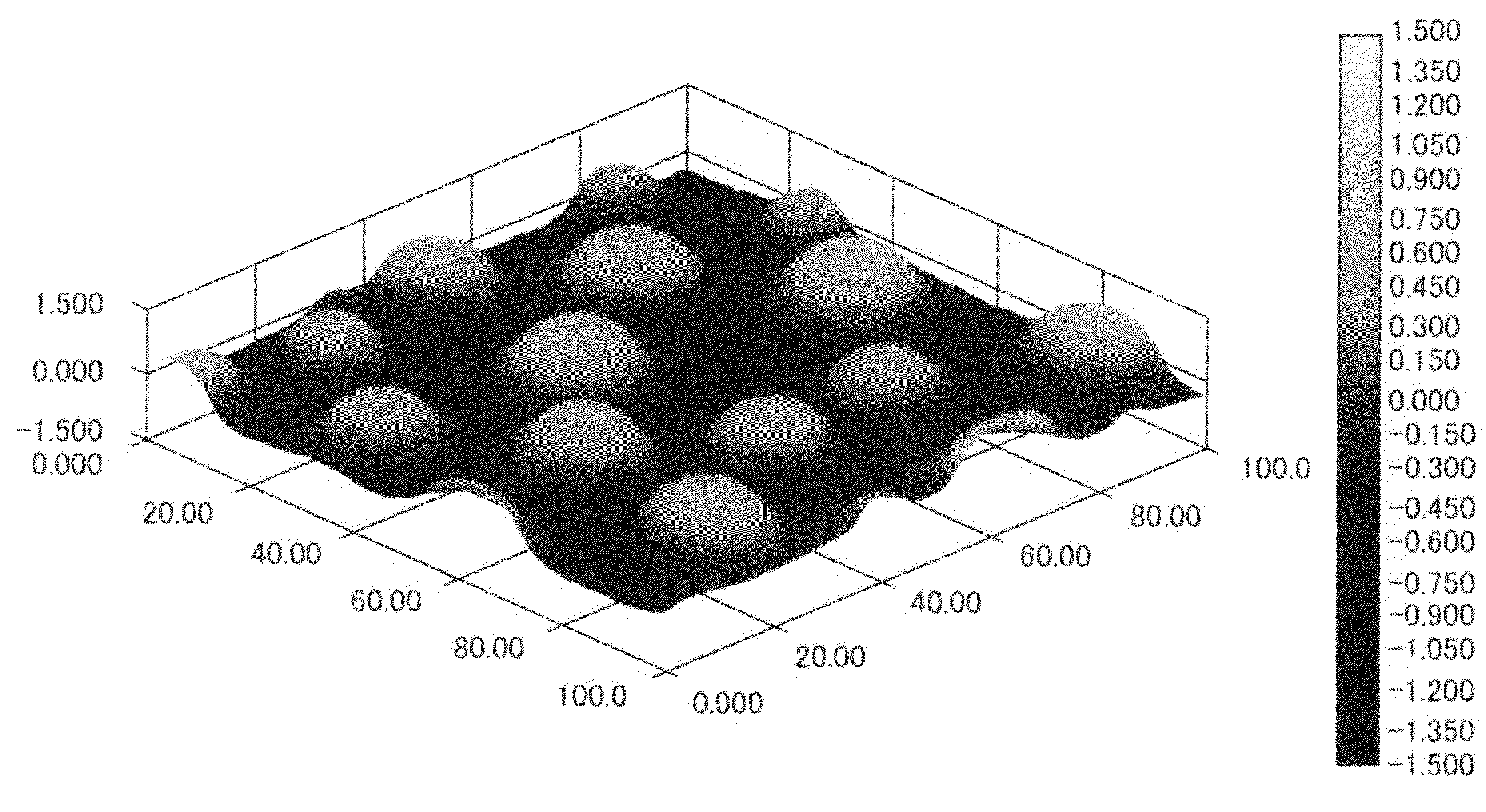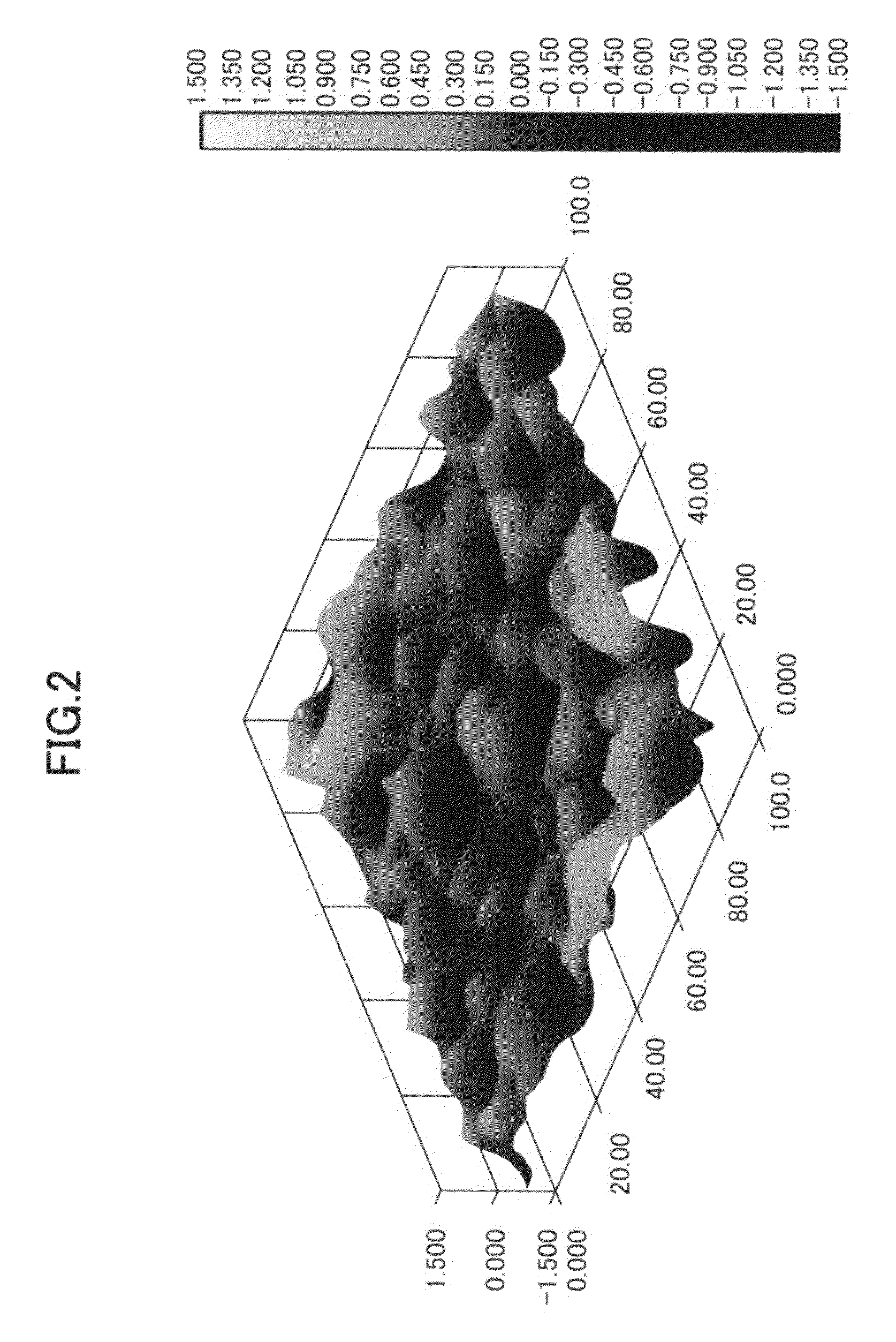Anti-glare glass substrate
a technology of glass substrate and glare reduction, which is applied in the direction of optical elements, instruments, transportation and packaging, etc., can solve the problems of uneven scattering of display light rays outputted by the lcd device, dispersion of light rays on each pixel, etc., and achieves excellent visibility and smooth writing of information thereon.
- Summary
- Abstract
- Description
- Claims
- Application Information
AI Technical Summary
Benefits of technology
Problems solved by technology
Method used
Image
Examples
example 1
1. Preparation of Coating Liquid for Forming Anti-Glare Coating
Preparation of Silica Sol (A):
[0076]Tetraethoxy-silane (Si(OC2H5)4) was used as a starting alkoxide, water for hydrolysis was added thereto so that the molar ratio: water / alkoxide was adjusted to 8, nitric acid as an acid catalyst was likewise added to the starting alkoxide so as to adjust the molar ratio: nitric acid / water to 0.01 and ethanol as a solvent was added thereto in such a manner that the solid content of the reaction solution was set at a level of 9% by mass as expressed in terms of the concentration converted into that of SiO2, after the completion of the hydrolysis. The resulting mixed liquid was hydrolyzed and / or polycondensed by stirring the same at room temperature over 24 hours to thus give Silica Sol (A). The resulting Silica Sol (A) was found to have a number average molecular weight of 613.
Preparation of Silica Sol (B):
[0077]Phenyl triethoxy-silane (C6H5Si(OC2H5)3) was used as a starting alkoxide, wa...
example 2
[0084]The same procedures used in Example 1 were repeated except that the heating temperature after the completion of the coating operation was changed to 650° C. to thus prepare an anti-glare glass substrate. The results obtained in the observation of the coating surface are shown in FIG. 2. There were observed projection bodies on an approximately planar surface, but these projection bodies were not small hill-like projected bodies having a tip at the center thereof such as those observed for the anti-glare glass substrate prepared in Example 1, but small hill-like projection bodies whose central portion is depressed. The coating formed on the anti-glare glass substrate thus prepared was inspected for a variety of characteristic properties such as the surface roughness, the distribution density of the depressed portions per unit area, the 60-deg. relative-specular glossiness, the partial iridescence generated due to interference, the outward appearance of images displayed on LCD a...
example 3
[0085]The same procedures used in Example 1 were repeated except that Silica Sol (A) and Silica Sol (B) were blended together in a mixing ratio (by mass): Silica Sol (A) Silica Sol (B) of 2:1 and that the addition of Silica Sol (C) was omitted, to thus prepare an anti-glare glass substrate. The results obtained in the observation of the anti-glare coating thus prepared are shown in FIG. 3. Although fine cracks were formed on the coating between the neighboring projection bodies, there was observed a pattern of projection bodies formed on an approximately planar surface resulted from the bi-nodal phase separation.
[0086]The anti-glare thin film thus formed was inspected for a variety of characteristic properties such as the surface roughness, the distribution density of the projection bodies per unit area, the 60-deg. relative-specular glossiness, the partial iridescence generated due to interference, and the coating hardness. The results thus obtained are summarized in the foregoing ...
PUM
| Property | Measurement | Unit |
|---|---|---|
| Temperature | aaaaa | aaaaa |
| Length | aaaaa | aaaaa |
| Area | aaaaa | aaaaa |
Abstract
Description
Claims
Application Information
 Login to View More
Login to View More - R&D
- Intellectual Property
- Life Sciences
- Materials
- Tech Scout
- Unparalleled Data Quality
- Higher Quality Content
- 60% Fewer Hallucinations
Browse by: Latest US Patents, China's latest patents, Technical Efficacy Thesaurus, Application Domain, Technology Topic, Popular Technical Reports.
© 2025 PatSnap. All rights reserved.Legal|Privacy policy|Modern Slavery Act Transparency Statement|Sitemap|About US| Contact US: help@patsnap.com



